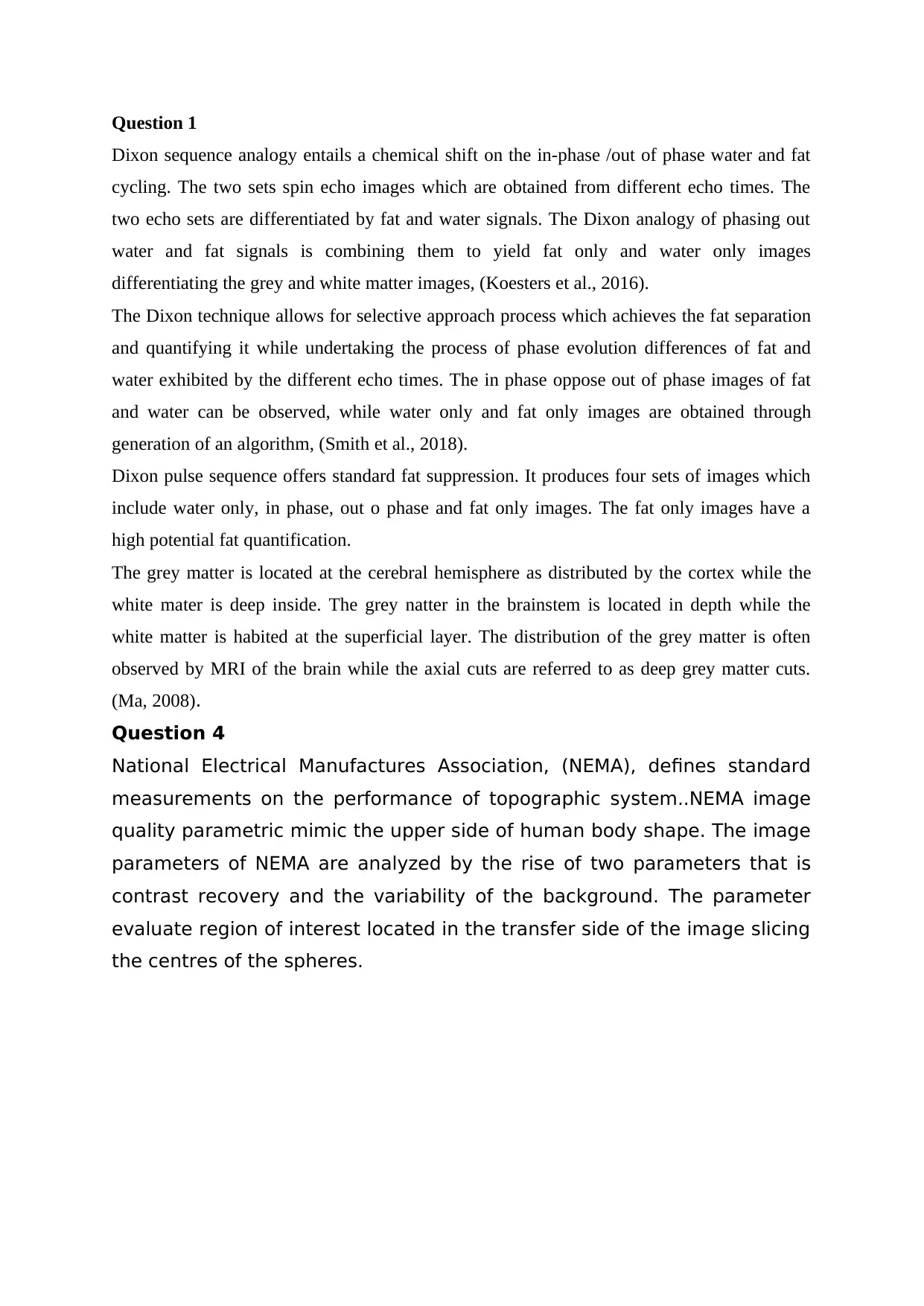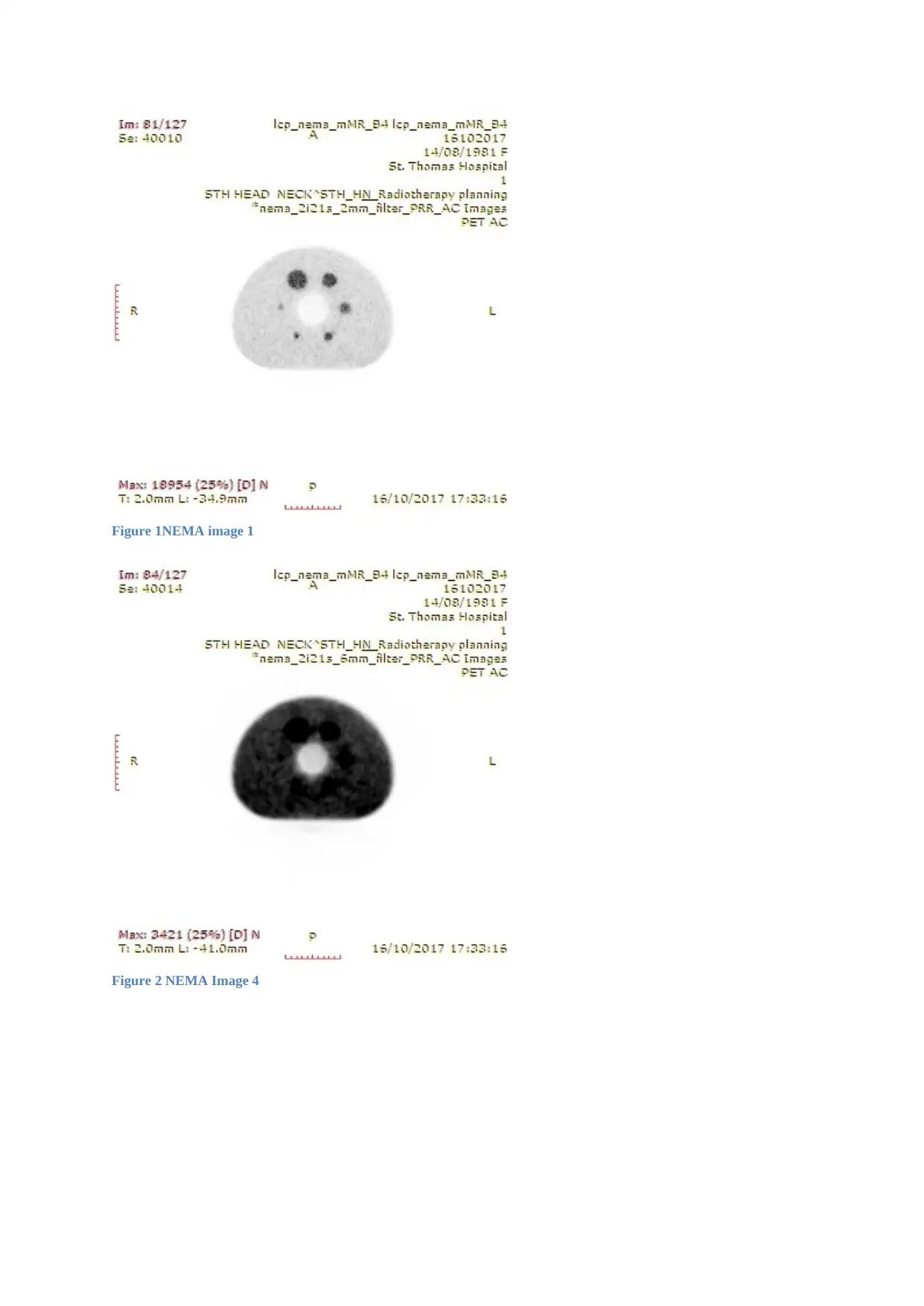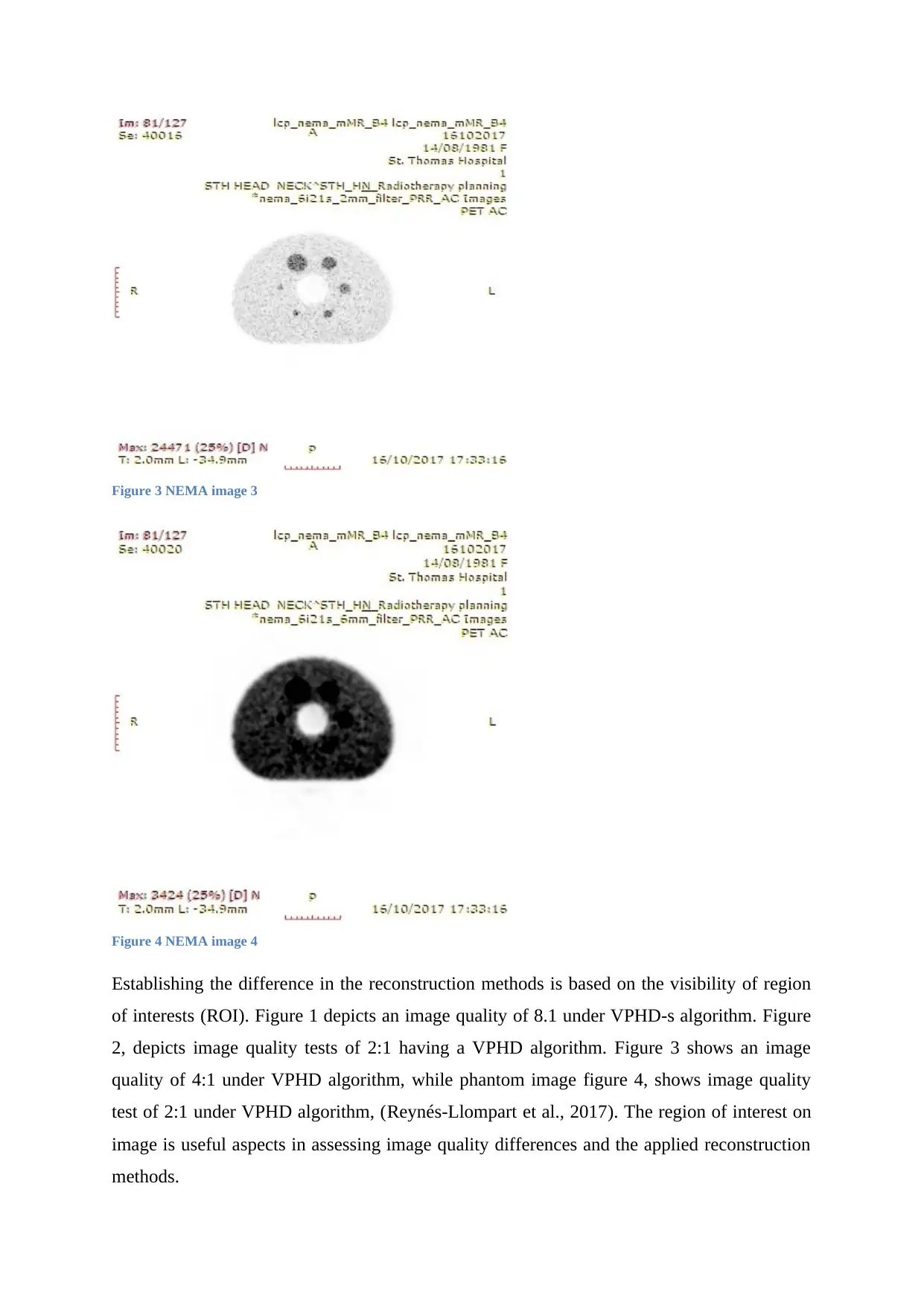Dixon Sequence Analogy for Fat and Water Imaging
VerifiedAdded on 2023/04/21
|4
|698
|292
AI Summary
This article discusses the Dixon sequence analogy for fat and water imaging in MRI. It explains the technique of combining fat and water signals to generate fat-only and water-only images. The article also explores the potential for fat quantification and the distribution of grey and white matter in the brain. References to relevant studies are provided.
Contribute Materials
Your contribution can guide someone’s learning journey. Share your
documents today.

Question 1
Dixon sequence analogy entails a chemical shift on the in-phase /out of phase water and fat
cycling. The two sets spin echo images which are obtained from different echo times. The
two echo sets are differentiated by fat and water signals. The Dixon analogy of phasing out
water and fat signals is combining them to yield fat only and water only images
differentiating the grey and white matter images, (Koesters et al., 2016).
The Dixon technique allows for selective approach process which achieves the fat separation
and quantifying it while undertaking the process of phase evolution differences of fat and
water exhibited by the different echo times. The in phase oppose out of phase images of fat
and water can be observed, while water only and fat only images are obtained through
generation of an algorithm, (Smith et al., 2018).
Dixon pulse sequence offers standard fat suppression. It produces four sets of images which
include water only, in phase, out o phase and fat only images. The fat only images have a
high potential fat quantification.
The grey matter is located at the cerebral hemisphere as distributed by the cortex while the
white mater is deep inside. The grey natter in the brainstem is located in depth while the
white matter is habited at the superficial layer. The distribution of the grey matter is often
observed by MRI of the brain while the axial cuts are referred to as deep grey matter cuts.
(Ma, 2008).
Question 4
National Electrical Manufactures Association, (NEMA), defines standard
measurements on the performance of topographic system..NEMA image
quality parametric mimic the upper side of human body shape. The image
parameters of NEMA are analyzed by the rise of two parameters that is
contrast recovery and the variability of the background. The parameter
evaluate region of interest located in the transfer side of the image slicing
the centres of the spheres.
Dixon sequence analogy entails a chemical shift on the in-phase /out of phase water and fat
cycling. The two sets spin echo images which are obtained from different echo times. The
two echo sets are differentiated by fat and water signals. The Dixon analogy of phasing out
water and fat signals is combining them to yield fat only and water only images
differentiating the grey and white matter images, (Koesters et al., 2016).
The Dixon technique allows for selective approach process which achieves the fat separation
and quantifying it while undertaking the process of phase evolution differences of fat and
water exhibited by the different echo times. The in phase oppose out of phase images of fat
and water can be observed, while water only and fat only images are obtained through
generation of an algorithm, (Smith et al., 2018).
Dixon pulse sequence offers standard fat suppression. It produces four sets of images which
include water only, in phase, out o phase and fat only images. The fat only images have a
high potential fat quantification.
The grey matter is located at the cerebral hemisphere as distributed by the cortex while the
white mater is deep inside. The grey natter in the brainstem is located in depth while the
white matter is habited at the superficial layer. The distribution of the grey matter is often
observed by MRI of the brain while the axial cuts are referred to as deep grey matter cuts.
(Ma, 2008).
Question 4
National Electrical Manufactures Association, (NEMA), defines standard
measurements on the performance of topographic system..NEMA image
quality parametric mimic the upper side of human body shape. The image
parameters of NEMA are analyzed by the rise of two parameters that is
contrast recovery and the variability of the background. The parameter
evaluate region of interest located in the transfer side of the image slicing
the centres of the spheres.
Secure Best Marks with AI Grader
Need help grading? Try our AI Grader for instant feedback on your assignments.

Figure 1NEMA image 1
Figure 2 NEMA Image 4
Figure 2 NEMA Image 4

Figure 3 NEMA image 3
Figure 4 NEMA image 4
Establishing the difference in the reconstruction methods is based on the visibility of region
of interests (ROI). Figure 1 depicts an image quality of 8.1 under VPHD-s algorithm. Figure
2, depicts image quality tests of 2:1 having a VPHD algorithm. Figure 3 shows an image
quality of 4:1 under VPHD algorithm, while phantom image figure 4, shows image quality
test of 2:1 under VPHD algorithm, (Reynés-Llompart et al., 2017). The region of interest on
image is useful aspects in assessing image quality differences and the applied reconstruction
methods.
Figure 4 NEMA image 4
Establishing the difference in the reconstruction methods is based on the visibility of region
of interests (ROI). Figure 1 depicts an image quality of 8.1 under VPHD-s algorithm. Figure
2, depicts image quality tests of 2:1 having a VPHD algorithm. Figure 3 shows an image
quality of 4:1 under VPHD algorithm, while phantom image figure 4, shows image quality
test of 2:1 under VPHD algorithm, (Reynés-Llompart et al., 2017). The region of interest on
image is useful aspects in assessing image quality differences and the applied reconstruction
methods.

References
Koesters, T., Friedman, K.P., Fenchel, M., Zhan, Y., Hermosillo, G., Babb, J., Jelescu, I.O.,
Faul, D., Boada, F.E. and Shepherd, T.M., 2016. Dixon sequence with superimposed model-
based bone compartment provides highly accurate PET/MR attenuation correction of the
brain. Journal of Nuclear Medicine, 57(6), pp.918-924.
Ma, J., 2008. Dixon techniques for water and fat imaging. Journal of Magnetic Resonance
Imaging: An Official Journal of the International Society for Magnetic Resonance in
Medicine, 28(3), pp.543-558.
Reynés-Llompart, G., Gámez-Cenzano, C., Romero-Zayas, I., Rodríguez-Bel, L., Vercher-
Conejero, J.L. and Martí-Climent, J.M., 2017. Performance characteristics of the whole-body
discovery IQ PET/CT system. Journal of Nuclear Medicine, 58(7), pp.1155-1161.
Smith, A.K., Dortch, R.D., Dethrage, L.M., Lyttle, B.D., Kang, H., Welch, E.B. and Smith,
S.A., 2017. Incorporating dixon multi‐echo fat water separation for novel quantitative
magnetization transfer of the human optic nerve in vivo. Magnetic resonance in medicine,
77(2), pp.707-716.
Koesters, T., Friedman, K.P., Fenchel, M., Zhan, Y., Hermosillo, G., Babb, J., Jelescu, I.O.,
Faul, D., Boada, F.E. and Shepherd, T.M., 2016. Dixon sequence with superimposed model-
based bone compartment provides highly accurate PET/MR attenuation correction of the
brain. Journal of Nuclear Medicine, 57(6), pp.918-924.
Ma, J., 2008. Dixon techniques for water and fat imaging. Journal of Magnetic Resonance
Imaging: An Official Journal of the International Society for Magnetic Resonance in
Medicine, 28(3), pp.543-558.
Reynés-Llompart, G., Gámez-Cenzano, C., Romero-Zayas, I., Rodríguez-Bel, L., Vercher-
Conejero, J.L. and Martí-Climent, J.M., 2017. Performance characteristics of the whole-body
discovery IQ PET/CT system. Journal of Nuclear Medicine, 58(7), pp.1155-1161.
Smith, A.K., Dortch, R.D., Dethrage, L.M., Lyttle, B.D., Kang, H., Welch, E.B. and Smith,
S.A., 2017. Incorporating dixon multi‐echo fat water separation for novel quantitative
magnetization transfer of the human optic nerve in vivo. Magnetic resonance in medicine,
77(2), pp.707-716.
1 out of 4
Your All-in-One AI-Powered Toolkit for Academic Success.
+13062052269
info@desklib.com
Available 24*7 on WhatsApp / Email
![[object Object]](/_next/static/media/star-bottom.7253800d.svg)
Unlock your academic potential
© 2024 | Zucol Services PVT LTD | All rights reserved.